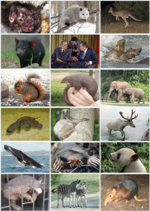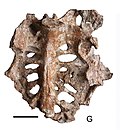Search results
The page "Graviportal legs" does not exist. You can create a draft and submit it for review or request that a redirect be created, but consider checking the search results below to see whether the topic is already covered.
- overall heavy torso would impede such a behavior. Nonetheless, similarly graviportal creatures have much thicker long bones. In 2016, zoologist Markus Lambertz...21 KB (2,292 words) - 03:36, 3 March 2024
- preservation). Applying this method likewise gives results suggesting a heavyset graviportal animal, with calculated values being similar to those of moas and elephant...16 KB (1,755 words) - 01:23, 8 April 2024
- the same general form as a hippopotamus. They have a graviportal skeleton, with four stubby legs and four toes on each foot, supporting a portly frame...32 KB (3,641 words) - 23:47, 20 May 2024
- non-sauropod ("prosauropod") sauropodomorphs. Its bones are robust and it had a graviportal limb arrangement, a key character trait of basal sauropodomorphs. While...7 KB (732 words) - 13:23, 5 May 2024
- long footprint. As massive quadrupeds, sauropods developed specialized "graviportal" (weight-bearing) limbs. The hind feet were broad, and retained three...83 KB (9,181 words) - 05:38, 21 May 2024
- bodies with short tails and legs, and an hourglass-shaped skull with a long snout.: 3, 19 Their skeletal structures are graviportal, adapted to carrying their...76 KB (8,425 words) - 01:18, 20 May 2024
- very large semi-aquatic mammals, and their barrel-shaped bodies have graviportal skeletal structures, adapted to carrying their enormous weight, and their...212 KB (22,687 words) - 04:39, 21 May 2024
- convergent with those of elephants and sauropod dinosaurs with their likewise graviportal (heavy and slow moving) builds. Unlike such animals, which tend to lengthen...63 KB (6,965 words) - 16:54, 4 January 2024
- Initially bipedal, as their size increased they evolved a four-legged graviportal gait adapted only to walking slowly on land, like elephants. The early...24 KB (2,132 words) - 13:04, 12 May 2024
- Callovian-Oxfordian, from China much larger species are known, with long, "graviportal" (adapted for moving only in a slow manner on land due to a high body...47 KB (5,290 words) - 00:30, 5 March 2024
- glyptodontines like Neosclerocalyptus and Doedicurus. Glyptodon had graviportal (weight-bearing), short limbs that are very similar to those in other...118 KB (12,942 words) - 01:36, 17 April 2024
- 1007/s00015-010-0024-2. S2CID 132746786. Calculating the speed of Quadrupedal graviportal animals by Ruben Molina-Perez, Asier Larramendi Rajewski, Genevieve (May...100 KB (12,106 words) - 10:17, 19 May 2024
- carapace, making the pelvis entirely immobile. Glyptotherium was very graviportal and had short limbs that are very similar to those in other glyptodonts...101 KB (10,999 words) - 04:16, 6 May 2024
- They instead suggested that the dinosaur fit the criteria of being a graviportal (or slow-moving) biped. An ungual phalanx measuring 21 millimeters (0...89 KB (10,053 words) - 22:36, 17 May 2024
- Romania) shows several primitive features. Its femur shows that it was a graviportal form rather than cursorial, not adapted for running. Due to fragmentary...19 KB (2,226 words) - 19:09, 21 April 2024
- C.; Billet, G.; Cornette, R.; Houssaye, A. (2022). "Adaptation to graviportality in Rhinocerotoidea? An investigation through the long bone shape variation...327 KB (34,449 words) - 06:34, 13 May 2024
- adaptation for open environments and long strides and a greater degree of graviportality, than in the case of Notiomastodon. This is also reflected in the build...93 KB (11,265 words) - 00:11, 20 May 2024
- Walter Coombs argued based on their limb anatomy that stegosaurs were graviportal animals. 1979 P.M. Yadagiri and Krishnan Ayyasami described the new genus...47 KB (4,206 words) - 19:57, 20 February 2024
















